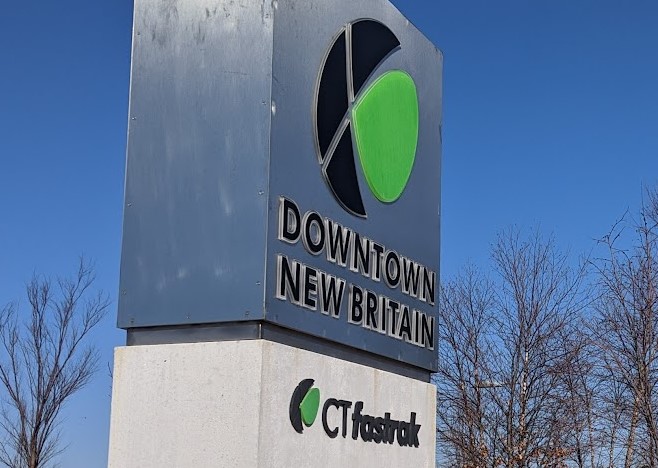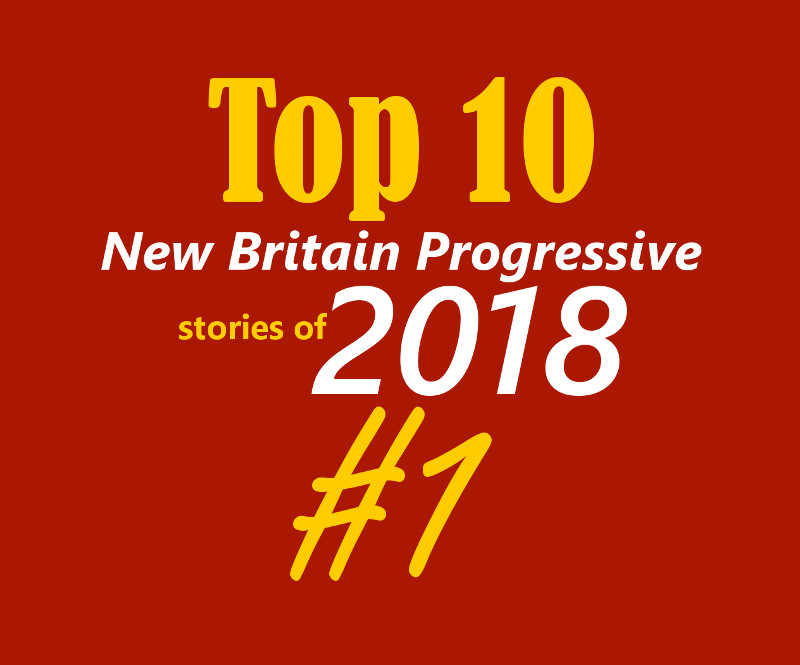
Top 10 of 2018: #1 – Stewart Watershed Mining Plan Defeated, Again
Many important stories have been covered by the New Britain Progressive in 2018. It may be difficult to name only a few articles as the top stories of the year, but there are a few the New Britain Progressive would like to share as our Top Ten. Other Top Ten stories can be found at “Top Ten Stories of 2018.”
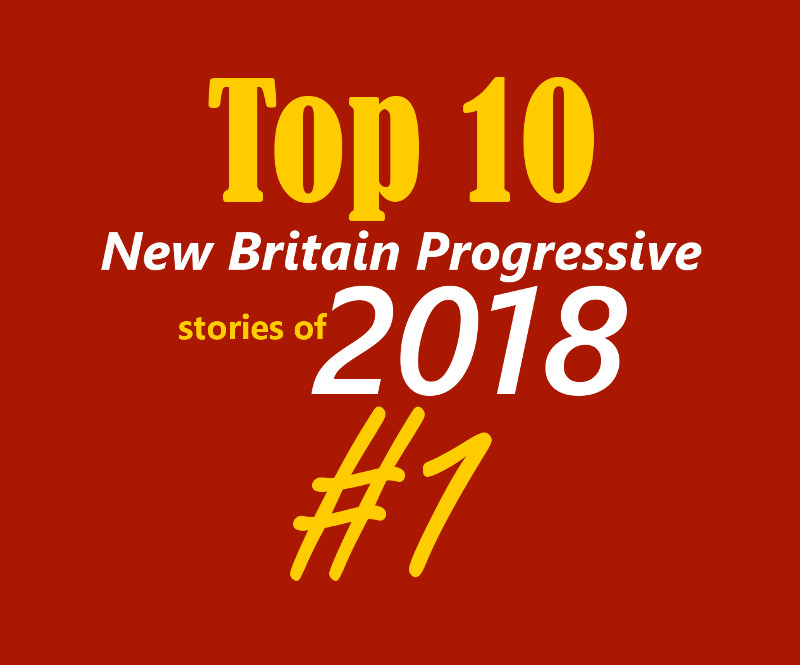
Republican Mayor Erin Stewart’s proposal to allow the strip mining of New Britain’s protecting drinking watershed land was defeated when Stewart withdrew her proposal just two days before the state Water Planning Council (WPC) and the Council on Environmental Quality (CEQ) was set to release damning a report about the plan. (Two Days Before State Report, Stewart Withdraws Watershed Mining Plan)
It was the second time the plan to allow the Tilcon company to strip mine in New Britain’s drinking watershed land went down to defeat under a Stewart mayor. Stewart’s father, former Republican Mayor Timothy Stewart, attempted to do so in 2007, and his plan was defeated amid strong public opposition.
The younger Stewart began the most recent attempt to allow the watershed mining in early 2016, leading to a two and a half year struggle by community residents against her plan.
The mining proposal was to have involved removing a large section of a hill at an upstream part the watershed of New Britain’s primary drinking water reservoir, the Shuttle Meadow Reservoir. Stewart has been pressing forward with the watershed mining plan since at least February of 2016, spending approximately $337,000 of water fee-payer funds to advance the proposal.
In March of 2018, Lenard Engineering, Inc. completed a report, done as part of a process for the city to request that it be permitted to allow the watershed strip mining. (Study Commissioned by City on Strip Mining Watershed Land Submitted to State)
That report was sent to the WPC and CEQ for them to review. A state law charged the two councils with preparing advice to be submitted to the state legislature. Since the proposed mining on protected watershed land would require a special exception or change in state law, only the state legislature would be able to authorize it.
The Lenard report lent support to Stewart’s case that the strip mining was needed in order to create a new “storage reservoir” in the hole left after the mining would be complete. The report claimed that increased demand for water over the next forty years would necessitate the increased storage capacity that the “storage reservoir”, it was purported, would create. But the claim of increased future demand for water appeared to be called into question by publicly available facts. (Do New Britain Residents Really Need the Proposed “Storage Reservoir”?)
The process leading up to the final reports by the WPC and CEQ included a public hearing, which was held in June. (Hearing on Stewart Watershed Strip Mining Plan Set for Jun 26th) Preliminary reports by the WPC and CEQ were scathingly critical of the mining plans, and the public expressed overwhelming opposition to the watershed mining at the hearing. (Overwhelming Opposition to Stewart Drinking Watershed Mining Proposal)
Stewart pressured the WPC and CEQ to complete their reports by August of 2018, which they prepared to do.
Then, just before the two state councils were set to release their final report, Stewart abruptly withdrew the mining plan. (Two Days Before State Report, Stewart Withdraws Watershed Mining Plan)
But the two state councils issued their report, anyway. The report was a damning rebuke of the watershed mining proposal and the alleged “storage reservoir” claim. The WPC and CEQ concluded that, “that the need for the proposed new reservoir has not been substantiated and based upon their separate reviews both the WPC and the CEQ find that the proposal’s risks to the current public water system and the environment are significant.” (Stewart Watershed Mining Plan Slammed by State Commissions)
The latest defeat of the drinking watershed mining plan ends a sordid chapter in the city’s history. At a similar time, in 2016, to when Stewart started to publicly push for allowing strip mining of the city’s drinking watershed land, she also sought to sell the one million-plus gallon per day Patton Brook Well to the Town of Southington, whose support was important for winning approval of the watershed mining plan. Stewart claimed that the well was not needed by the city and would be expensive for New Britain to use a source of water.
But Stewart’s plans to sell the Patton Brook Well began to unwind in October of 2016 when the New Britain Progressive exposed that New Britain was in a drought-condition water supply alert. City officials under Stewart were aware that the city was facing a water shortage for months during the summer 2016, but Stewart asked city residents to conserve water by, among other things, “limiting the watering of things like lawns, gardens, driveways, and sidewalks,” in October of 2016, only one day after the New Britain Progressive exposed the water supply alert.
Stewart’s claim that bringing Patton Brook Well water to New Britain would be impractical and would take $1 million to do was later proven as false when water was flowing from the Patton Brook Well into New Britain’s primary drinking water reservoir by the end of 2017. But, by then, the city’s water rate payers were already on the hook for more $400,000 extra for water from the regional Metropolitan District Commission (MDC) because water supplies under Stewart’s administration had run so low.
This is the second time that the Stewart drinking watershed mining plan has been defeated, but it is not clear that it will be the last. While Stewart’s letter withdrawing her proposal would appear to mean that this city will not push for it in the state legislative session that begins this week, she vaguely left the door open for continued consideration of, “what measures may be required to ensure that we are responsibly addressing ongoing concerns regarding the adequate supply of clean public water.” Perhaps we have not seen the last of the Stewart plan to allow strip-mining of New Britain’s protected drinking watershed land.
But the end of the two and a half year long latest attempt to allow this mining was very significant, and was #1 of the Top Ten stories covered by the New Britain Progressive in 2018.
Stewart Watershed Mining Plan Slammed by State Commissions
August 25, 2018
Republican Mayor Erin Stewart’s proposal to allow the strip mining of New Britain’s protecting drinking watershed land was broadly slammed by two key state commissions, the Water Planning Council (WPC) and the Council on Environmental Quality (CEQ).
The two commissions were responding to a state law that required that they provide their recommendations on Stewart’s proposal that would involve removing a large section of a hill at an upstream part of the watershed of New Britain’s primary drinking water reservoir, the Shuttle Meadow Reservoir, in a strip mining operation that would remove massive qualities of rock that is a part of land owned by the city.

The Water Planning Council and the Council on Environmental Quality concluded that, “that the need for the proposed new reservoir has not been substantiated and based upon their separate reviews both the WPC and the CEQ find that the proposal’s risks to the current public water system and the environment are significant. Thus, both the WPC and CEQ are opposed to the City of New Britain’s proposal for the proposed quarry expansion and future water storage reservoir.”
Stewart had withdrawn her proposal as the Water Planning Council was set to meet on August 24, 2018 to approve its recommendations. The August 24th date was the same as the date that Stewart had pointedly stated that the two commissions were required to submit their recommendations to the state legislature, in a letter she sent to the WPC on July 10th.
However, the Water Planning Council proceeded with their meeting, anyway, approving their recommendation to the legislature that the mining plan not be approved.
At the public hearing held on the proposal on June 26th, public reaction to the watershed mining plan was nearly all in opposition.
“I would like to thank the public for speaking out against this proposal,” said the Council President, Ald. Eva Magnuszewski (D-AL). “Protecting our natural resources, especially water is of utmost importance.”
During the course of backing plan, Stewart committed over $350,000 of taxpayer funds to Lenard Engineering, leading to the study that presented underpinning of a case for mining of drinking watershed land as a way to create a new “storage reservoir” for the city.
In its analysis of that report prior to the June 26th hearing, the Water Planning Council (WPC) said “the WPC finds that the city’s report does not substantiate the need for the proposed new reservoir or, in fact, that the proposed reservoir would even be a viable public water storage facility. Based on this review, the WPC finds that the proposal’s risks to the current public water system and the environment are significant and the city’s report does not make a plausible case for undertaking such an activity and, therefore, does not justify the loss of forest and the ecological, recreational and environmental impacts.”
In that same analysis, the Water Planning Council also said that, “the WPC finds that preparation for quarrying, including clearcutting the forest and removing the stumps, soil and other natural material, followed by quarry operations, would eliminate much of the wild habitat of the site while creating the potential for decades of increased risk to the city’s nearby Shuttle Meadow Reservoir.”
Bottom line,” said Magnuszewski. “There are alternatives to gas and oil but there is no alternative to water.”
“I hope the City is refunded the $354,000.00 that was spent on this study!,” added Magnuszewski, noting that the money could have been used for public services in New Britain. “Tilcon should have paid for the study not the city!”
The Water Planning Council, in consultation with the Council on Environmental Quality, has been charged with preparing advice to be submitted to the state legislature. Since the proposed mining on protected watershed land would require a special exception or change in state law, only the state legislature can decide to authorize it.
While Stewart’s letter withdrawing her immediate proposal would appear to keep it from going any further in the upcoming legislative session, she vaguely left the door open for continued consideration of, “what measures may be required to ensure that we are responsibly addressing ongoing concerns regarding the adequate supply of clean public water.”
But, in comments on August 2nd, the Council on Environmental Quality said that, “There is no proven need for a 2.3 billion gallon drinking water reserve in New Britain.” The CEQ also pointed out that, “New Britain’s loss of potable water during transmission is about 25% higher than the norm and the rate of loss has been increasing.” The CEQ has also pointed out the large loss of water from apparent leaky pipes in the city in a report it released on May 25th.
The immediate withdrawal by Stewart of her watershed mining plan is the second time she has backed down from a proposal on a major watershed plan in the wake of strong public opposition.
At a similar time, in 2016, to when Stewart started to publicly push for allowing strip mining of the city’s drinking watershed land, she also sought to sell the one million-plus gallon per day Patton Brook Well to the Town of Southington. Southington’s support was important for winning approval of the watershed mining plan. But Stewart’s plans to sell the Patton Brook Well began to unwind in October of 2016 when the New Britain Progressive (which was called the New Britain Independent at the time) exposed that New Britain was in a drought-condition water supply alert (“New Britain in a ‘water supply alert’“).
Public opposition to the plan to sell the Patton Brook Well gained even more momentum in 2017 as severe drought conditions and the need to purchase water from the regional Metropolitan District Commission contradicted Stewart’s statements that the well was not needed by New Britain. By April, 2017, in the face of increasing pressure, Stewart gave up on the Patton Brook Well sale plans (“Amid Growing Questions and a Democratic Resolution, Stewart and Council Republicans Abandon Patton Brook Sale“).
By the end of 2017, water was flowing from the Patton Brook Well into New Britain’s primary drinking water reservoir, contradicting Stewart’s previous claim that bringing Patton Brook Well water to New Britain would be impractical and would take $1 million to do (“City Taps Patton Brook Well For Water After Calling Off Bargain Basement Sale, Hiking Rates To Pay For MDC Water“).
Two Days Before State Report, Stewart Withdraws Watershed Mining Plan
August 24, 2018
Just two days before a key state decision regarding Republican Mayor Erin Stewart’s plan to allow strip-mining on New Britain’s protected drinking watershed land, Stewart has withdrawn the proposal.
Stewart’s withdrawal of the mining plan comes just before an August 24, 2018 special meeting of the state Water Planning Council (WPC). The WPC has previously been critical of the watershed mining plan. The meeting was called specifically for the WPC to make its final recommendations concerning the plan.
The meeting was held and the WPC approved recommendations, which were not not available as of the publication of this article. The August 24th date of the WPC meeting is the same date cited by Stewart in a letter that she sent to the Water Planning Council on July 10, 2018. In that letter, Stewart pointedly told the Water Planning Council that it, and another key state commission, the Council on Environmental Quality, are charged under law with providing the state legislature with a recommendation on the watershed mining plan, “within 60 days of the public hearing (August 24),” that the city held on the plan on June 26th.
Since the proposed mining would be on protected watershed land, it require a special exception or change in state law that only the state legislature would be able to authorize it.
Comments from the public were nearly all in opposition to the mining plan at the June 26th public hearing on the proposal, which was held in front of the City Council and the Board of Water Commissioners.
“I would like to thank the public for speaking out against this proposal,” said the City Council President, Ald. Eva Magnuszewski (D-AL). “Protecting our natural resources, especially water is of utmost importance.”
The mining proposal was to have involved removing a large section of a hill at an upstream part the watershed of New Britain’s primary drinking water reservoir, the Shuttle Meadow Reservoir. Stewart has been pressing forward with the watershed mining plan since at least February of 2016, spending approximately $350,000 of taxpayer funds to advance the proposal.
The Water Planning Council and the Council on Environmental Quality previously issued scathing criticisms of the report done for the Stewart administration by Lenard Engineering that supported the need for new “storage reservoir” which would, under the proposal, be created by the strip mining of the city’s watershed land. The Stewart administration has defended the plan to strip mine on New Britain’s drinking watershed land with the claim it would leave behind a new reservoir for the city.
Critics have claimed that plan is a dubious excuse for allowing the Tilcon company to mine the land.
The Water Planning Council’s previous report confirmed the critics’ concerns, saying that, “the WPC finds that the city’s report does not substantiate the need for the proposed new reservoir or, in fact, that the proposed reservoir would even be a viable public water storage facility. Based on this review, the WPC finds that the proposal’s risks to the current public water system and the environment are significant and the city’s report does not make a plausible case for undertaking such an activity and, therefore, does not justify the loss of forest and the ecological, recreational and environmental impacts.”
The WPC raised concerns about the quality of New Britain’s drinking water that may result from the mining, saying that, “Much of the area that would be impacted in the proposed expanded area of quarrying is located in the active public drinking water supply watershed of the Shuttle Meadow Reservoir. Surficial activities associated with the quarrying operation, including clear-cutting the forest and removing the stumps, soil and other natural material could create a significant water quality risk to the reservoir.”
“Bottom line,” said Magnuszewski, “there are alternatives to gas and oil but there is no alternative to water.”
“I hope the City is refunded the $354,000.00 that was spent on this study!,” added Magnuszewski. “Tilcon should have paid for the study, not the city!,”
Stewart’s apparent withdrawal of the watershed mining plan would be the second of her administration’s major watershed proposals that she has abandoned amid strong public opposition.
Stewart’s public push to allow Tilcon to strip-mine in New Britain’s protected drinking watershed land starting in 2016 at a similar time to when she also sought to sell the one million-plus gallon per day Patton Brook Well to the Town of Southington, whose support was important for winning approval of the watershed mining plan. Stewart’s plans to sell the Patton Brook Well began to unwind in October of 2016 when the New Britain Progressive (which was called the New Britain Independent at the time) broke the news that New Britain was in a drought-condition water supply alert.
Stewart admitted to the existence of the water supply alert one day after the New Britain Progressive broke the news about it. She proceeded to urge residents not to water their lawns and gardens in October for a water supply alert condition known to city officials during the entire summer of 2016.
Public opposition to the plan to sell the Patton Brook Well gained even more momentum in 2017 as severe drought conditions and the need to purchase water from the regional Metropolitan District Commission contradicted Stewart’s statements that the well was not needed by New Britain. By April, 2017, in the face of increasing pressure, Stewart gave up on the Patton Brook Well sale plans.
By the end of 2017, water was flowing from the Patton Brook Well into New Britain’s primary drinking water reservoir, directly contracting Stewart’s previous claim that bringing Patton Brook Well water to New Britain would be impractical and would take $1 million to do.
The City Council also recently defeated a proposal Stewart had made to sell to sell fifteen acres of New Britain owned Class 3 watershed land to the town of Burlington, apparently with Stewart having decided to withdraw her support for the plan. That proposal also had met with public opposition.
Overwhelming Opposition to Stewart Drinking Watershed Mining Proposal
June 27, 2018
Huge opposition met Republican Mayor Erin Stewart’s controversial plan to allow strip mining on New Britain drinking watershed land at the public hearing held on June 26, 2018 in front of the City Council and the Board of Water Commissioners.
Speaker after speaker spoke in opposition to the plan at a packed hearing in the auditorium at Gaffney Elementary School. Speaker after speaker in opposition to the plan was loudly applauded by the large crowd.

The public opposition at the hearing comes after reports from two key state commissions, the Water Planning Council and the Council on Environmental Quality, issued scathing criticisms of the report done for the Stewart administration by Lenard Engineering, that supported the need for new “storage reservoir” that would, under the proposal, be created by the strip mining of the city’s watershed land.
The state commissions’ reports raised concerns about the safety of drinking water, environmental damage and taxpayer costs as a result of the mining. The commissions also presented withering criticism of the claim that the new “storage reservoir” is even needed.
The watershed mining plans would involve removing a large section of a hill at an upstream part the watershed of New Britain’s primary drinking water reservoir, the Shuttle Meadow Reservoir. The proposal was earlier pressed for by Stewart’s father, Timothy Stewart, when he was mayor. Despite the elder Stewart’s strong support for the plans, the proposal was defeated.
On February 13, 2016, Erin Stewart began a public move to resurrect the plans of the elder Stewart to allow Tilcon to strip mine city drinking watershed land. According to Protect Our Watersheds CT, the younger Stewart had “…letters delivered into the mailboxes of residents near the Tilcon quarry about a ‘great new reservoir plan’…”.
Stewart has claimed on Twitter that, “I have not formed an opinion yet,” and that, “what this process is all about info gathering then to make a decision…”
But, in a February 17, 2016 article, the New Britain City Journal Stewart quoted Stewart as supporting the watershed strip mining plan, telling residents that blasting from current mining on Tilcon land, “is up to 300 feet from residents’ backyards. If this passes it will never again be that close.”
In that article, Stewart portrayed the watershed mining plan as a proposal to create a new reservoir, saying, “This is a no brainer to build another reservoir.” She also said, “In an effort to preserve a safe drinking water source for all future generations we would like to pursue this opportunity now.”
While Stewart, who is a candidate for the Republican nomination for Lieutenant Governor, has sought to maintain a public image of indecision on the widely unpopular watershed mining plan, she has consistently directed city resources toward promotion of the mining proposal.
Stewart committed over $350,000 of taxpayer funds to Lenard Engineering, leading to the study that presented underpinning of a case for mining of drinking watershed land as a way to create a new “storage reservoir” for the city.
And a month after the letters in which Stewart offered up the “great new reservoir plan” the city, under Stewart, was registered as having hired the lobbying firm of Gaffney, Bennett & Associates, the same lobbying firm that had been employed by the Tilcon company to lobby the state legislature. Tilcon would only be permitted to mine New Britain’s watershed land with the permission of the state legislature.
While Stewart has defended the plan to strip mine on New Britain’s drinking watershed land with the claim it would leave behind a new reservoir for the city, critics have said that plan is a dubious excuse for allowing the Tilcon company to mine the land.
The report from the two state commissions have validated those concerns, and many public comments at the June 26th hearing echoed points raised in these commissions’ findings.
The Water Planning Council (WPC) said “the WPC finds that the city’s report does not substantiate the need for the proposed new reservoir or, in fact, that the proposed reservoir would even be a viable public water storage facility. Based on this review, the WPC finds that the proposal’s risks to the current public water system and the environment are significant and the city’s report does not make a plausible case for undertaking such an activity and, therefore, does not justify the loss of forest and the ecological, recreational and environmental impacts.”
That commission also said that, “the WPC finds that preparation for quarrying, including clearcutting the forest and removing the stumps, soil and other natural material, followed by quarry operations, would eliminate much of the wild habitat of the site while creating the potential for decades of increased risk to the city’s nearby Shuttle Meadow Reservoir.”
The WPC found the alleged need for the proposed “storage reservoir” to be flawed. “The city’s report relies upon the confluence of a series of speculative and undocumented contingencies relative to both water demand and supply occurring in unison in order to justify the need for a new reservoir. The chance of all of these contingencies occurring is extremely remote. Therefore, the need for this 2.31 billion gallon storage reservoir has not been documented.”
The WPC also wrote that, “The city’s Water Supply Plan and the [Water Utility Coordinating Committee (WUCC)] Integrated Report show that the New Britain Water Department has excess water supply with respect to demand now and through the 50-year planning period, even using the increased demand projections provided by Lenard Engineering, without a new reservoir.”
The WPC raised concerns about the quality of New Britain’s drinking water that may result from the mining, saying that, “Much of the area that would be impacted in the proposed expanded area of quarrying is located in the active public drinking water supply watershed of the Shuttle Meadow Reservoir. Surficial activities associated with the quarrying operation, including clear-cutting the forest and removing the stumps, soil and other natural material could create a significant water quality risk to the reservoir.”
The WPC also noted, “that drainage from the construction sequence and incremental construction activities would occur in areas that would remain in the watershed draining to the Shuttle Meadow Reservoir. There would be a prolonged (decades-long) risk to reservoir water quality due to these activities in the existing drinking water watershed. There does not appear to be adequate analysis of this in the report.”
The WPC also raised concerns about the effect of the quality of city drinking water as a result of water coming from the proposed “storage reservoir”.
The WPC wrote that that Lenard report, “documents detectable concentrations of perchlorate in the surface water that currently exists at the quarry. The United States Environmental Protection Agency (EPA) has determined that perchlorate is a human health risk and has indicated this contaminant will be regulated in the future.”
The WPC added that, “TCE and 1,2,4-trichlorobenzene were detected in the raw water quality monitoring. TCE is a known human carcinogen and is a drinking water contaminant regulated by CT DPH and EPA under the SDWA. … There is a health risk associated with TCE and with 1,2,4-trichlorobenzene, which is also a regulated contaminant.”
The WPC also raised concerns that the depth of the proposed “storage reservoir”, 130 feet, may create conditions resulting in the metal, manganese, entering the water. The WPC said that, “The city’s report did not evaluate the potential for manganese to exceed water quality standards in the proposed reservoir. … Manganese is being studied by the EPA under the UCMR4 for possible future regulation in public drinking water.”
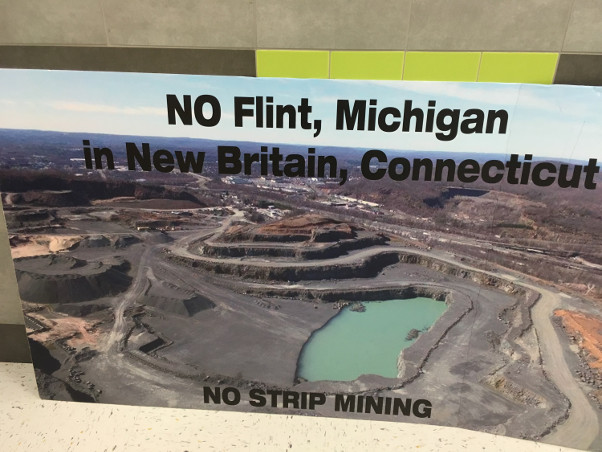
The Lenard report already conceded that that “storage reservoir” would not have enough land surrounding it to fill it, instead relying on water transported some distance from “flood-skimming” water from the Coppermine Brook.
The WPC, however, questioned Lenard’s analysis on behalf of the city of the drinking water quality of this “flood-skimming” water. “The city’s report only considered the water quality of Coppermine Brook under low or normal streamflow, not during the higher stream flow periods when flood-skimming would occur. Water quality is likely to be significantly different at that time. In particular, the water is likely to have very different levels of organic chemicals, inorganic chemicals, microorganisms including legionella, crypto, giardia, sediments and other organic matters that can get washed into the brook as rain water passes through the streets and the terrain of the Coppermine Brook watershed.”
The WPC raised the concern that, “This lower quality water will then be pumped to be stored in the proposed quarry reservoir and the subsequent residence period is conducive to the proliferation of a long list of contaminants, such as perchlorate or industrial solvents, that the existing treatment plant may not have the capacity to properly treat.”
The WPC also questioned the cost-effectiveness of filling the proposed “storage reservoir” with water transported from Coppermine Brook. “The report also does not analyze or discuss the costs of pumping such a large volume of water (2.31 billion gallons) from Coppermine Brook to the site to initially fill the reservoir or the future cost of pumping replacement water. The operational costs could be considerable.”
The environmental effects of the mining would be significant, according to the WPC. “There are multiple significant environmental issues and impacts which arise in connection with the proposed quarry/ reservoir. These fall chiefly within the categories of core forest impacts, vernal pool and wetland impacts, impacts to State-listed species, relocation of the Metacomet Trail and inconsistencies with the Connecticut Water Quality Standards.”
“Three State-listed species of special concern,” the WPC said, “namely the eastern box turtle, the spotted turtle and the Jefferson salamander, would be impacted by the development of this reservoir. In addition, four plant species currently known only from historic records may occur on this site, and one of these, last reported in Connecticut in 1879, was identified on the project site within the footprint of the reservoir.”
The WPC added that, “several other plant species may occur at the project site and should be surveyed for,” including Goldenseal (Hydrastis canadensis), Tall white bog orchid (Platanthera dilatada), Short-stalked false bindweed (Calystegia sylvatica).
The state’s Council on Environmental Quality (CEQ) also raised significant concerns about the mining plan. “It is the conclusion of the Council that the environmental consequences of the proposal would be adverse and that the need for the additional water storage capacity is not established in the report. Its assumptions about increased demand and reduced supply posit the worst extremes of each. The potential for reductions in demand is not fully considered.”
The CEQ wrote that, “The proposal that is the focus of the Report would replace a significant portion of a nearly 700 ft. high mountain with a 139 acre, 130 ft. deep reservoir. It would have no natural source other than rain water and ground water and would need to be filled primarily from stormwater runoff from other sources.”
“It would eliminate 13.6 acres of Class I watershed land and 111.9 acres of Class II watershed land that now contribute to New Britain’s West Canal and Shuttle Meadow Reservoir to allow for the operation of a commercial rock mining operation for an estimated period of forty years,” the CEQ added.
The CEQ said that new proposed reservoir, “If built, it would be the deepest lake entirely within Connecticut’s borders (130 feet). Concerns have been raised about water quality in the reservoir which would be filled primarily with surface storm water runoff (flood skimmed water), which is among the dirtiest of water sources and carries the risk of high treatment costs.”
The CEQ took special aim at the environmental consequences of the proposed strip mining. “The Report’s executive summary (Chapter 1) and its comparison of benefits versus environmental impacts (Chapter 13) understate important environmental consequences of the proposed project. Those consequences, which appear in other chapters of the Report, include loss of habitat for, or risk to, at least four species of special concern, three imperiled landscapes and displacement of a trail of regional significance. ”
The CEQ noted that the Lenard report, “makes clear that the impact for some of the resident flora and fauna is obliteration. Clearing and removing overburden on the proposed expansion area would eliminate entire habitats. The impact for other species, and for transient species, such as raptors and other migratory birds, would be diminished habitat.”
The CEQ criticized that, “Though the possibility of mitigation for some of the environmental damage is mentioned in the Report, specifics as to exactly what mitigation would occur and where it would be is absent, as is analysis of its likely success.”
The WPC pointed out that, if water storage capacity were, indeed, a priority for the city, other alternatives could be explored. “The report does not clearly indicate whether or not the water used to fill the quarry reservoir would otherwise be usable in an existing reservoir. … Although not mentioned in the city’s report, the nearby Plainville Reservoir was issued an abandonment permit in 1997. The report does not mention this water body or provide an analysis of its potential future reuse for water supply.”
Likewise, the CEQ wrote that, “Crescent Lake, a decommissioned reservoir, lies within sight of the proposed reservoir, though no mention is made of recommissioning it to supplement the City’s reserve. The potential of water conservation is not fully considered.”
The CEQ analysis also refers to potential opportunities for water conservation as a way ensure adequate water supply.
“Using the most conservative estimates for passive conservation,” the CEQ wrote, “there could be a decrease of 10 gallons per capita per day by 2040. An effort by the City of New Britain to reduce outdoor water use would reduce demand even further.”
The CEQ calls into question the fixing leaky pipes as a way to address water supply needs. “The Report does not factor in a reduction in unaccounted-for water. New Britain’s loss of potable water during transmission is about 25% higher than the norm.”
The CEQ says that the Lenard report, “shows an ever-increasing amount of water that is unaccounted for over the last five years. This five-year average is masking what appears to be an increasingly leak-prone water distribution system.”
With the June 26th public hearing complete, the Water Planning Council, in consultation with the Council on Environmental Quality, will prepare advice that will be submitted to the state legislature. Since the proposed mining on protected watershed land would require a special exception or change in state law, only the state legislature can decide to authorize it.
Editor’s Note: Video reporting by video journalist Antonio C. Lavoy, Sr. contributed to this article.
Do New Britain Residents Really Need the Proposed “Storage Reservoir”?
March 10, 2018
Publicly available information may call into question the conclusions in the recently released report done for the city administration of Republican Mayor Erin Stewart by Lenard Engineering, Inc., that justifies the strip mining of protected drinking watershed land by saying that increased demand for water over the next forty years would necessitate a new “storage reservoir” created in the hole left after the mining is complete.
The report was done as part of a process for the city to request that it be permitted to allow strip mining on New Britain’s protected watershed lands by the Tilcon company.
Water from Patton Brook culvert flowing into Shuttle Meadow reservoir.
The Lenard report says that more water is needed because the demands on New Britain’s water system will be increasing by 1.55 MGD (million gallons per day) from 9.39 MGD in 2015 to 10.94 MGD in 2060. The report says that the new “storage reservoir” would be capable meeting that increase by storing enough water brought from other places to increase New Britain’s available water supply, “by approximately 2 MGD over current estimates, up to approximately 20.20 MGD.”
But the historical data used in the report shows that the total consumptive use of water by New Britain residents and businesses and sales to other towns has actually gone down between 2011 and 2015, from 7.31 MGD to 6.99 MGD. The total direct sales of water to New Britain residents and businesses decreased from 5.63 MGD to 5.42 MGD, and sales to other towns went down, as well, from 1.68 MGD to 1.57 MGD.
The total consumption of water did increase from 9.08 MGD average daily demand in 2011 to 9.39 MGD in 2015, but that increase appears to have been entirely from a category listed in the report as, “Unaccounted-for Non-Revenue Water,” a category not including residential or business water use or water system backwashing or fire-fighting.
Nearly half of the increase in water use that Lenard has projected for the years between now and the year 2060 appear to be based on very high projections of New Britain population growth. This is significant, since Lenard’s calculation of New Britain’s future water consumption was calculated by simply multiplying its future population estimates by the amount of 52 gallon per person per day. Any overestimation in New Britain’s population would make the city’s future water needs appear higher than it would likely be.
For its New Britain population projections in the years 2025, 2030 and 2040, Lenard said it used data from the Connecticut Data Center at UConn. The data that the Center projected was based on current available town by town information on, “birth and mortality data from the Connecticut Department of Public Health, migration data derived from U.S. Census Bureau Decennial Census, and birth and death data from the Connecticut Department of Public Health.” But, the Connecticut Data Center cautions about the reliability of its population predictions, saying,
These projections do not claim to predict the future, as population dynamics can be influenced by economic, policy, individual decisions, and other aspects which are not accounted for in the projections model. These projections serve as a point of reference for state agencies, regional planning organizations, municipalities, researchers, and other organizations but the actual outcome may differ from the projections.
Even with this caution, from the data’s own authors, it appears that Lenard actually did use this data to predict the future water needs of the city to the year 2040.
Lenard apparently took this data even further in its own calculation of New Britain’s population for the year 2060. Lenard’s report said that, in making that calculation, it, “utilized the growth rate between 2030 and 2040 values, and assumed a similar growth to estimate the 2060 population value.” The difference between the 2030 and 2040 projections would posit a growth of 2,080 people in New Britain over that ten year period. Lenard’s calculations doubled that number to suggest that a growth of another 4,160 would occur over the twenty years from 2040 to 2060.
Lenard’s report suggests that New Britain, in 2060, will have reached its highest population, ever, at 85,149, above the population the city had fifty years ago, in its industrial heyday.
Lenard’s conclusion also appears to be contradicted by the New Britain Plan of Conservation and Development, cited in its report, which says that New Britain is unlikely to experience the new housing growth that would be needed to support such a large population growth. The New Britain Progressive calculates that, for the city to grow to 85,149 people, more than 4,600 new units of housing may have to be constructed in New Britain. Lenard cites the city development plan as saying that, “Under existing zoning, nearly 1,500 new dwelling units could be built in the City,” but adding that, “Due to a variety of of factors, this level of development is unlikely to occur.”
Lenard also used the same estimates of population growth to infer how much water demand will increase among commercial, governmental and other water users in the city. Therefore all of Lenard’s estimates of growing water use in New Britain, residential, commercial, industrial, governmental, etc., were based on these population estimates.
Data from the United State Bureau of the Census shows that New Britain’s population was 71,538 in the year 2000, 70,193 in 2005, 73,206 in 2010 and 72,570 in 2016. The average of those numbers is 71,877. Those historic population figures have fluctuated, up and down, within about 2.35% from that average, between 2000 and 2016.
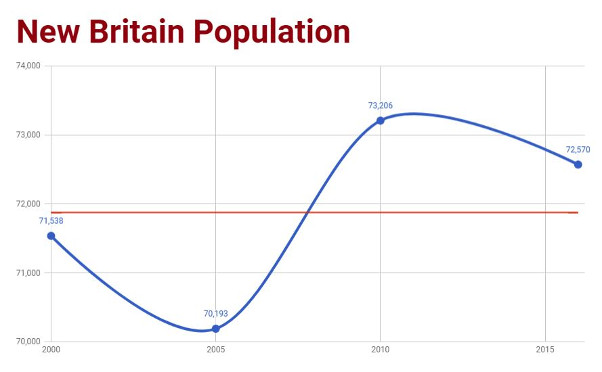
If New Britain’s population remained at around that average, then the total water use by New Britain residents and New Britain commercial, industrial, governmental and other users would appear to remain similar to or less than current levels into the future.
However, Lenard’s estimates of increasing demand for water on the New Britain water system, as a whole, are based more on the demands it expects will come from other towns than from New Britain water users. Even using its high New Britain population estimates, Lenard’s predicted increase in water use by New Britain residents and commercial, industrial, governmental and other water users was 0.86 MGD between 2015 and 2060. This is less than the 0.90 MGD increase in water consumption that Lenard predicted coming from other towns.
The Lenard report says water use from residents, business and others in the Kensington Fire District are expected to, “increase by approximately 161,000 gpd, or 17% in the 45 year period between 2015 and 2060.” The abbreviation “gpd” refers to “gallons per day.”
Even though water purchased by the Berlin Water Control Commission from New Britain decreased between 2011 and 2015 by 0.42 MGD, the Lenard report says that Berlin Water’s use of New Britain water is, “estimated to increase by 161,000 gpd over the next 45 years, or approximately 13%.” The report says that the increase would be, “to meet a portion of the future growth in Berlin.”
The city of Bristol also purchases water from New Britain, but Lenard says that it made assumptions about Bristol’s future purchases from New Britain because, “Detailed information on Bristol’s system, as well as existing and future water demand projections were not available from Bristol for this report.”
While Bristol’s purchase of water from New Britain between 2011 and 2015 has remained close to its average of 0.24 MGD, Lenard’s report assumed that Bristol’s purchases from New Britain would nearly double to 0.5 MGD. Lenard explained its estimate by saying that it, “assumed that Bristol would utilize their New Britain connection up to the current 500,000 gpd permit value.” That assumption would mean that Bristol’s use of New Britain water would be at the maximum possible level between 2020 and 2060, despite its recent use being half that amount.
Though the Lenard study reported no recent purchases of water from Valley Water Systems, Lenard assumed that this private water company would purchase 200,000 gpd from 2020 to 2060. Valley Water Systems serves customers in Plainville, Southington and Farmington. Even though Lenard’s study points out that Valley Water’s total demand is decreasing, and that, “Valley Water Systems and New Britain have no formal contract for the purchase of water,” Lenard’s projected demand on New Britain’s water system assumed New Britain would sell Valley Water the full 200,000 gpd it is permitted by the state to sell, during the entire period from 2020 to 2060.
Without Lenard’s assumption of increased water demand by Bristol and Valley Water and without the Lenard’s assumption of increased water use by New Britain residents, businesses and others, the total consumptive use of water might increase by 0.45 MGD by 2060, well less than the 1.76 MGD predicted by the numbers Lenard presented in its report.
All of that 0.45 MGD increase would be attributable to increase water demand in Kensington and Berlin. With the Lenard report, as well and the Stewart administration, defending the strip mining on New Britain’s drinking water land with the case that it will create a new reservoir, this may raise the possibility that the primary beneficiaries resulting from the mining may be towns other than New Britain. It may also raise the possibility that the main result of the environmental harms of the mining that the Lenard report enumerated may be the facilitation further suburban development.
The Lenard report also appears to have miscalculated the amount of water that its assumptions would indicate would go to what is called “non revenue consumption,” most of which is in a category referred to as “unaccounted for.” Lenard says that, in its predictions of future water use, it calculated that, “an allowance of 25% for future non-revenue consumption is provided, which is similar to 2014 and 2015 values.” The percentages Lenard presented for those years calculate to percentages of the total system water usage. The numbers Lenard published for 2020, 2030 and 2060, however, calculate to only twenty percent, indicating that Lenard calculated this category lower than its assumptions would indicate.
Including the full twenty-five percent assumed by Lenard for the “unaccounted for” category into calculations that only include increased water usage by Kensington and Berlin would show an increase in water use for the entire New Britain water system of 0.60 MGD between 2015 and 2060. This would be an amount considerably less than the 1.55 MGD that Lenard predicted, and would be entirely attributable to increased consumption in Kensington and Berlin.
The Stewart administration has consistently defended the plan to strip mine on New Britain’s drinking watershed land with the claim it would leave behind a new reservoir for the city. Critics have claimed that plan is a dubious excuse for allowing the Tilcon company to mine the land. The Lenard study appears to confirm what many critics have been saying about the proposed new reservoir, that filling it with water would require that water be transported from other places, rather than being filled from water flowing the surrounding land. The Lenard study refers to the proposed reservoir, in its recent report, as a “storage reservoir”.
The question of whether to allow strip mining on New Britain’s protected watershed land is expected to continue to be a controversial issue, especially as the community continues to examine the case made for the mining and the Lenard report, now presented to the state as part of that proposal.
Editor’s note: The full study, which is a large, 500MB, file can be downloaded from the state Water Planning Council by clicking on this link.
Related articles:
New Britain in a “water supply alert”.
Stewart Admits to Water Supply Alert
City Hall Watch: Stewart Wants More Money For Tilcon Watershed Study; Costs To Exceed $350K
Top 10 of 2017: #4 – Exposing New Britain’s “Watergate”


